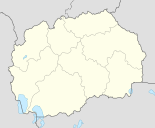Capari
| Capari Цапари |
||||
|---|---|---|---|---|
|
||||
| Basic data | ||||
| Region : | Pelagonia | |||
| Municipality : | Bitola | |||
| Coordinates : | 41 ° 3 ' N , 21 ° 11' E | |||
| Height : | 1010 m. i. J. | |||
| Residents : | 493 (2002) | |||
| Postal code : | 7313 | |||
| License plate : | BT | |||
Capari ( Cyrillic Цапари , Albanian Capari ) is a village in southeastern North Macedonia in the municipality of Bitola in the Pelagonia region . Until 2004 it was the capital of a municipality of the same name .
geography
The village of Capari is located around 15 km west of Bitola in the direction of Resen , on the northern slopes of the Pelister Mountains in the Gjavatkol area on the upper course of the Šemnica River.
history
For the first time Capari was mentioned in an Ottoman tax register from 1622/23. After the establishment of the Bulgarian Exarchate , a Bulgarian primary school was established here in the 1870s. A village church, St. George's, was subsequently built (1888).
During the Ilinden uprising , Capari, along with the villages of Gjavoto and Smilevo , was the center of the rebels in the revolutionary region of Bitola. 96 insurgents from Capari died during the uprising. The last battles with the Ottoman army in the region took place here. In 1906 a memorial with the bones was erected in the courtyard of the Georgskirche. After the bloody suppression of the uprising by the Ottomans, a large part of the population emigrated to Bulgaria, but above all to the USA .
During the Balkan Wars of 1912/13, volunteers from Capari fought in the Macedonia-Adrianople Volunteer Corps of the Bulgarian army against the Ottoman and Serbian armies . After the Treaty of Bucharest , the place, like all of Macedonia, was assigned to the Kingdom of Serbia . On April 29, 1913, officers of the Black Hand wreaked havoc on the male population in Capari.
During the First World War , the region and Capari temporarily came under Bulgarian rule. During this time, Capari and the nearby Srpci formed the municipality of Capari in Okolija Bitola. Capari was the capital of the municipality and had 1704 inhabitants. After the end of the war, Capari belonged to the Kingdom of Serbs, Croats and Slovenes .
During the Second World War , Capari became Bulgarian again for three years. When the place was assigned to communist Yugoslavia after the war , the majority of the population (over 2000 inhabitants) emigrated to Australia in the 1950s. In the following years the “Memorial for the Fallen in the Ilinden Uprising” and the Bulgarian military cemetery were destroyed by the communist rulers. To this end, a new "Memorial to the Fallen for the Freedom of Macedonia" was erected in the center of the village, in which the bones of fallen partisans were also buried.
Capari has belonged to the independent Republic of Macedonia since 1991.
Attractions
- George's Church, built in 1888
- St. Petka Monastery, consecrated in 1847.
- Bulgarian military cemetery
People associated with the city
- Konstantin Beltschew (1874–1922), BMARK activist and Bulgarian politician
- Mikhail Mukew , Bulgarian politician
- Pawel Christo (1874–1922), IMRO activist and leader of the Ohrid Debar uprising

